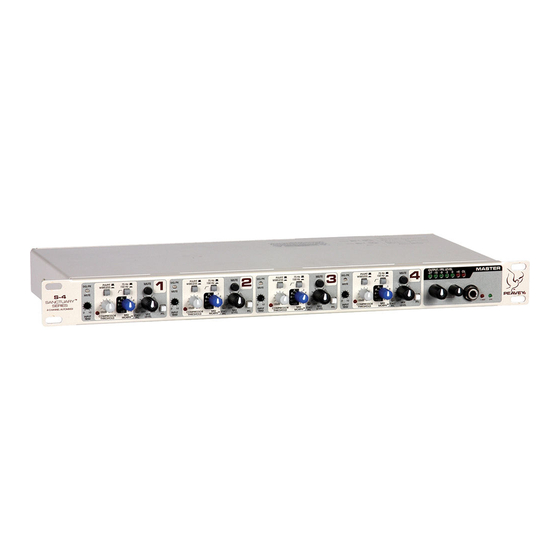
Summary of Contents for Peavey S 4
- Page 1 Automatic Mixer Operating Guide For more information on other great Peavey products, go to your local Peavey dealer or online at www.peavey.com...
- Page 3 Duration Per Day In Hours Sound Level dBA, Slow Response ⁄ ⁄ ⁄ or less...
- Page 4 Description The Sanctuary Series S-4 is a result of Peavey Electronic's continuing commitment to bring high quality sound and ease of operation to the worship environment. Automatic mixing is an important sound system tool that not only simplifies the mixing of spoken word microphones, but also improves sound quality and increases available microphone gain for soft-spoken individuals.
- Page 5 CHANNEL & MASTER FUNCTIONS...
- Page 6 1. INPUT TRIM: This control adjusts the gain of the input preamplifier, which sets the operating level for the channel. We recommend that the gain be adjusted so that ringing does not occur with the channel’s mix level control set to maximum. The signal present LED (green) should be lit most of the time and the clip LED (red) should never light.
- Page 7 8. MIX LEVEL: This control adjusts the level of the channel in the main output. It is a part of the Automix ™ circuitry and affects priority and sharing ratios. It is recommended that the gain be set to keep this control between 12 o’clock and full clockwise.
- Page 8 20. MAIN OUTPUT LEVEL: This back panel control is an attenuator on the main XLR and 1/4" outputs. It is provided to match the nominal operating levels of the S-4 ™ to the inputs of either a mixing console, power amplifier or recording device.
-
Page 9: Setup And Application
SETUP AND APPLICATION The S-4 ™ is a versatile mixer with features that allow it to be used in many applications and connected in many ways. It is difficult to cover all applications here, but four different schemes are detailed below. Read through the suggested methods and determine what best fits your needs. - Page 10 Sub-mixer: Existing sound systems can also benefit from Automix ™ technology by the addition of one or more S-4 ™ automatic mixers. The Automix feature increases the available microphone gain, reduces background noise and virtually eliminates comb-filtering on spoken word microphones. Spoken word microphones premixed by the S-4 are sent to one input on the existing mix console.
- Page 11 Automix ™ controller (console with post-fader direct outputs): If you want to add the power of automixing but still want the microphones with their own faders on your existing console, there are two approaches that can be used. The best Automix "controller" approach requires post-fader channel direct outputs on your mix console. Connect the mics to the console inputs, then send the console direct outputs to the line inputs on the S-4 ™...
- Page 12 Automix ™ controller (using S-4 ™ direct outputs): If console direct outputs are not available, an alternate approach can be used. Connect the direct outputs of the S-4 to the console line inputs. This approach gains most of the Automix advantages but has some potential weaknesses that need to be addressed.
-
Page 13: Setting Levels
SETTING LEVELS To get proper performance (low noise and distortion) from the S-4 ™ mixer and your sound system, the gain controls throughout the chain must be properly adjusted. There are two basic parts to this process: setting the S-4 operating levels and the operating levels of the mix console or sound system. - Page 14 Automix controller using mix Console Direct outputs: ™ Fig. 1 A. Connect your microphones to the mix console inputs. B. Connect the corresponding mix-console, post-fader channel direct outputs to the line inputs on the S-4 ™ Unity Gain Position C. Set the S-4 gain controls to the unity gain position shown in figure 1. D.
- Page 15 GLOSSARY Gain Amplification of an audio signal. A negative gain (in dB) is an attenuation or reduction of level of the signal. Ringing The resonance (“ringing”) sounds heard (often at the end of words) when the sound system is close to acoustic feedback.
-
Page 16: Block Diagram
™ Block Diagram... -
Page 17: Input Specifications
S - 4 ™ SPECIFICATIONS Input Specifications: Input Levels Input Z Bal / Input Gain Setting Connector Function (Ohms) Min Unbal Min** Nominal* XLR Input 2.2K Max Gain -64 dBu -56 dBu -48 dBu XLR: (150 Ohms) (68 db) Pin 1 Gnd, Pin 2 (+), Min Gain +2 dBu... - Page 19 Effective Date: July 1, 1998 Features and specifications subject to change without notice.
- Page 20 Features and specifications subject to change without notice. Peavey Electronics Corporation • 711 A Street • Meridian • MS • 39301 (601) 483-5365 • FAX (601) 486-1278 • www.sanctuary-series.com 80305173 ©2004 Printed in the U.S.A. 5/04...





